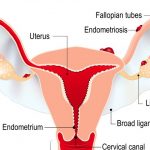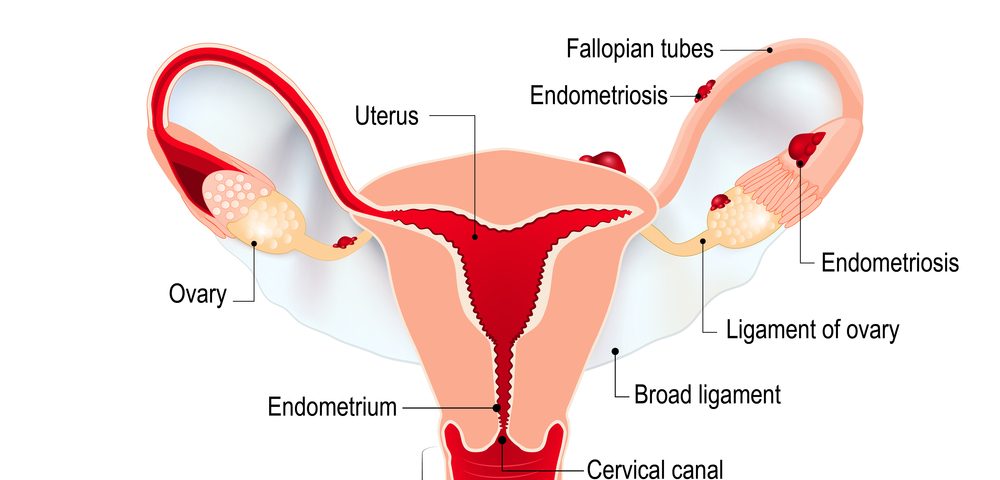Endometriosis is best described as a gynaecological disease of women characterised by a continuous distressing pain that can drive sufferers to depression and suicidal ideation.
It is one of the commonest benign gynaecological conditions that is diagnosed laparoscopically in 10 to 15 percent of women investigated for gynaecological complaints.
When the endometrial lining of your uterus is found in other organs like the ovaries, stomach, lungs, rectum, bladder, intestines, and umbilicus; then you have endometriosis.
Endometriosis was first described by Sampson in 1921. It is a disease that may affect women at any stage of their reproductive life. It used be very common among white women in their teens or early twenties but nowadays, many black women are being diagnosed laparoscopically with advanced disease.
In general, delay in diagnosis has a major impact on women’s quality of life, such as absence from work and marital difficulties due to chronic pelvic pains and dyspareunia.
The symptoms are usually disproportionate with to the laparoscopic findings while the correlation between endometriosis and subsequent reduced fertility is a major concern for women who desire pregnancy.
The symptoms of endometriosis include: severe menstrual pains, lower abdominal pain, lower back pain heavy menstrual bleeding, pain during sex, irregular period, pain on urination that worsens during your period, passage of blood in urine during your cycle, monthly passage of blood in stool, monthly rectal bleeding, cyclical coughing of blood, bluish swelling and bleeding from the umbilicus, and infertility.
The causes of endometriosis are not exactly known but so many theories like retrograde menstruation, family history, autoimmune disease, hormonal imbalance and some toxic environments have been put forward as possible causes or risk factors for endometriosis.
The diagnosis of endometriosis is laparoscopic and histologic examination.
Management and treatment of Endometriosis
Treatment involves the use of drugs for symptomatic relieve especially pains and sometimes radical surgery may be required to save and preserve your quality of life.
Medical Treatment- Use of Drugs
The goals of medical treatment of endometriosis are to reduce pains, interrupt your monthly flow and improve your quality of life. It involves the use of oral contraceptives, GnRH agonists, synthetic androgens, Non Steriodal Anti-inflammatory drugs (NSAIDs) and others.
Symptomatic endometriosis is usually manage medically using therapeutic agents that abolish the effect of estradiol on both the ectopic and eutopic endometrium. The following drugs are currently in use.
1. Hormone Therapy- Oral Contraceptive Pills 💊
The combined oral contraceptive pills (COCP) are effective in women with mild disease who do not have infertility. The COCP should used tricyclically, ie., three packets to be used continuously followed by one week break.
Similarly, progestational agents (Noresthisterone, Medroxyprogesterone and Dydrogesterone) can be used daily for 90 days followed by one week break. The main side-effects of hormonal treatment are, however, bloating, fluid retention, breast tenderness, nausea and weight gain.
2. Synthetic androgens- testosterone analogues
Danazol is not usually prescribed today because of androgenic side effects. It acts at the hypothalamic level to prevent the rise of gonadotropins thus inhibiting the ovarian steriodogenesis and binds to androgen receptors, sex hormone-bimding globulin and corticosteroid-binding globulin ro inhibit growth. Danazol is prescribed for 6 months at a maximum dose of 800mg daily. It greatly helps to relieve symptoms and improves quality of life.
Another synthetic androgen is Gestrinone that is more popular in Latin America given at a dose of 2.5mg twice weekly starting on the first day of your cycle.
The side-effects of these synthetic androgens include acne, oily skin, seborrhea, weight gain, oedema, muscle cramp, menopausal symptoms (excluding osteoporosis), hirsutism, deepening of voice, loss of libido, loss of appetite and depression. All these adverse effects is because of the testosteronic effect of both danazol and gestrinone.
3.GnRH agonist
GnRH stands for gonadotropin releasing hormone. Unlike the native GnRH, the agonists are compounds with longer half-lives and greater receptor affinity. When used, they cause down-regulation of the pituitary GnRH receptors, thus resulting in “medical oophorectomy”. The three agonists commonly used are Nafarelin nasal spray, 200mg or 400mg twice daily; Leuprolide acetate, a depot preparation at a monthly dose of 3.75mg and Goserelin administered by subcutaneous injection, 3.6mg monthly. The duration of treatment is six months though in every exceptional cases it is prescribed for longer duration under medical supervision.
Side effects are common, similar to menopausal symptoms, i.e. hot flushes, vaginal dryness, decreased libido, breast tenderness, insomnia, depression, irritability and fatigue, headache and skin changes. In view if these symptoms, hormone replacement therapy or Tibolone (2.5mg once daily) is generally prescribed as add-back therapy.
4. NSAIDs, Antidepressants, & Anti-oxudants
Non-steroidal anti-inflammatory drugs and prostaglandin synthetase inhibiting agents such as Diclofenac, Ibuprofen and Mafenamic acid are appropriate choices for single therapy if the your have mild premenstrual pain from minimal endometriosis. Care must be taken not to abuse NSAIDs because of gastric ulceration.
The use if anti-depressants such as Prozac may help a great deal un relieving acute pains.
Anti-oxidants have been suggested for patients with endometriosis because oxidative stress worsen symptoms. Take Vitamin C, plenty of fruits, plenty of water and rest.
Surgery
Sometimes you may need to go under the knife to get your life back from endometriosis. That is the truth.
Surgical treatment can be either conservative or radical. The former approach aims to conserve your reproductive potential by simply destroying endometriotic sites (laparoscopic laser ablation or diathermy) excision of endometriotic nodes, division of peritubo-ovarian adhesions, or may involve dissection of urinary tract, and the bowel. If there is obstruction of the bowel, a combined operation to resect the bowel by a colorectal surgeon is recommended. Ovarian cystectomy of an endometrioma is preferred to drainage as the former enhances spontaneous pregnancy and improves access if in-vitro fertilization is considered.
Presacral neurectomy at laparotomy and Laparoscopic Uterine Nerve Ablation (LUNA) using carbondioxide laser at laparoscopy has resulted in improvement of pelvic pains in some women.
In very severe pelvic endometriosis where fertility is not desired, total abdominal hysterectomy (removal of the womb) and bilateral salpingo-oophorectomy (removal of ovaries and fallopian tubes) is carried out followed by daily use of hormone replacement therapy/tibolone to prevent menopausal symptoms.

Courtesy: EndometriosisNews
Conclusion
Endometriosis is one of the challenges facing gynaecologists. Moreover, management is complicated by the fact that endometriosis is a chronic, progressive disease without a defining treatment strategy. Furthermore, whilst pelvic pain and infertilityare common symptoms, the systemic nature of endometriosis means that patients typically report a host of other symptoms not typically classified as gynaecological. An emdometriosis clinic with practitioners from multiple specialties would be an ideal enabling environment for patient support, information sharing, and structured management that would address the psychological and medical needs of patients.
Endometriosis journey is a rough and tortuous one. You need to join a support group
Partly adapted from Textbook of Obstetrics and Gynaecology by Akin Agboola.





















